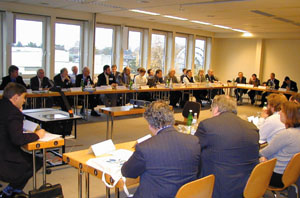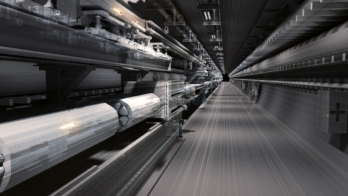Particle physics has been “big science” for a long time. Its ambitious projects are also becoming more and more international, for it is only this way that the necessary resources can be amassed. A recent meeting of a special working group of the Organization for Economic Cooperation and Development assessed future needs.

If science knows no geographical frontiers, then its parliaments too need to be international. One such platform is the Global Science Forum (GSF) of the influential Organization for Economic Cooperation and Development (OECD). The GSF, the successor to the OECD’s Megascience Forum, which was established in 1992, has set up working groups in several specialist areas, in which particle physics has always featured prominently.
A GSF meeting in London on 13-15 April 2000 agreed to form a Consultative Group to advise the GSF on charting a “roadmap” for high-energy physics over the coming 20-30 years to prepare the way for new large facilities.
The group’s membership of active physicists and scientific administrators represents OECD member states and also non-member states that have an active high-energy physics programme.
At the London meeting, the group was mandated to consider both accelerator- and non-accelerator-based experimental and theoretical particle physics, plus particle astrophysics, and to report to the GSF in mid-2002.
The GSF initiative has come during a period of rapid innovation in high-energy physics. The Large Hadron Collider is now being constructed at CERN with a collision energy seven times that of the Fermilab Tevatron. Japan, the US and Europe have all developed plans for the construction of a 0.5-1 TeV electron-positron linear collider. The physics case for such a collider is strong and complements that of the LHC. However, the construction costs of such a machine are high.
At the same time, new accelerator ideas have prompted promising R&D on muon storage rings and the resultant creation of intense neutrino beams. At higher energies, R&D on a multi-TeV electron-positron linear collider (CLIC) is continuing, and R&D is starting on muon colliders and higher-energy hadron colliders. In parallel, the marriage of astrophysics and particle physics at both the experimental and the theoretical level is resulting in a significant programme.
First meeting
Approximately 50 delegates attended the first meeting of the Consultative Group at DESY, Hamburg, on 9-11 November 2000, which was chaired by Ian Corbett of the UK. The meeting was also attended by observers from CERN; the various Asian, US, European and international high-energy physics communities (the Asian Committee for Future Accelerators, ACFA; the US High Energy Physics Advisory Panel, HEPAP; the European Committee for Future Accelerators ECFA; and the International Committee for Future Accelerators, ICFA); the particle astrophysics branch of the International Union of Pure and Applied Physics (IUPAP-PANAGIC); and the European Union. Future meetings of the group will be held at CERN, in Japan and in the US before the group reports to the GSF.
The meeting at DESY was especially relevant because of the proposed construction of a 500-800 GeV electron positron superconducting linear collider (TESLA) by an international collaboration in which DESY plays a central role. Following an introduction by Hermann-Friedrich Wagner of the German delegation, and a physics perspective by Brian Foster (Bristol), DESY director Albrecht Wagner described in detail the planning and prototype activities of the project. In particular, he showed impressive results achieved by the collaboration on the development of high-gradient accelerator cavities as part of the Tesla Test Facility (TTF2). This will be used as a high-intensity X-ray source from 2003 (the SASE FEL project; see Towards the ultimate X-ray source:the X-ray laser ). Wagner announced the submission in March of a Technical Design Report for consideration by the German Government, and he expressed ideas on how such a machine might be built (in particular, involving a Global Accelerator Network of national laboratories in the construction of the machine; see Accelerators to span the globe).
Peter Rosen from the US Department of Energy (DOE) pointed out the impressive new particle and nuclear physics facilities coming on line in the US (the upgraded TeV2 proton-antiproton collider at Fermilab; the B factory at SLAC, Stanford; and Brookhaven’s RHIC heavy ion collider) and the need to exploit these facilities. He noted ongoing R&D towards a high-energy electron-positron linear collider, towards the development of muon storage rings and hadron colliders beyond the LHC (VLHC). He said that the US community would discuss future perspectives at a Workshop in Snowmass in June-July, to be followed by an HEPAP panel that would report to the DOE and National Science Foundation later this year.
Long-term health
Ger van Middelkoop (NIKHEF), expressing the viewpoint of smaller European nations that have an active high energy physics activity, emphasized the importance of CERN to the long-term health of both European and international particle physics.
Noting the increasing international character of Japanese activities (the KEK B-Factory and the K2K neutrino project in Japan; LEP and the LHC at CERN; and CDF at Fermilab), Sakue Yamada (KEK) described the major accelerator R&D in Japan towards a high-energy electron-positron linear collider design using the Accelerator Test Facility (ATF) at KEK. He emphasized the importance of input from the physics communities before reaching decisions on the construction of the next accelerator facility.
Finally, Kurt Hübner from CERN described longer-term R&D towards CLIC, a CERN design for a multi-TeV electron-positron linear collider, and collaborations with other European laboratories on R&D towards a muon storage ring and intense neutrino beam. He also noted studies towards upgrading the intensity and/or energy of LHC beams.
In the following discussion there was vigorous support for increasing the R&D expenditure on accelerator technologies. There was also a strong plea to maintain some regional competition in the development of promising physics and accelerator programmes. Owing to the overlapping R&D activities in Europe, the US and Japan towards a 0.5-1 TeV electron-positron linear collider design, and with parties in each region pushing to build such a machine, “bottom-up” assessments of the high-energy physics situation have been requested. Reports from these bodies are expected during 2001. In particular, ECFA:
- is sponsoring an ECFA-DESY working group on physics and detectors at an electron-positron linear collider that will form part of the Technical Design Report for TESLA;
- is supporting a series of European R&D initiatives towards a muon storage ring and intense neutrino beam complex;
- has formed a working group chaired by Lorenzo Foà on the future of accelerator-based high-energy physics activities in Europe.
The working group, with its membership representing the different CERN member states, has been requested to reach a European physicist consensus on a roadmap for accelerator-based particle physics beyond LHC, as well as the infrastructure required and the R&D still needed. The group expects to be in a position to complete its report in in the middle of this year. At the same time, ICFA has created subgroups to study the technical and organizational issues related to Wagner’s Global Accelerator Network of accelerator construction.
The PANAGIC subgroup of IUPAP has recently reported to IUPAP the progress in charting its roadmap outlining key activities, and this was distributed by PANAGIC chairman Alessandro Bettini.
The GSF consultative group also set up a small subgroup to work with the OECD on the organizational and sociological issues of a “world laboratory”, and data will be collected on the funding and governmental policies of participating countries. These studies, together with the reports of ICFA, ECFA, ACFA, HEPAP and PANAGIC, will provide the major input to the consultative group.





